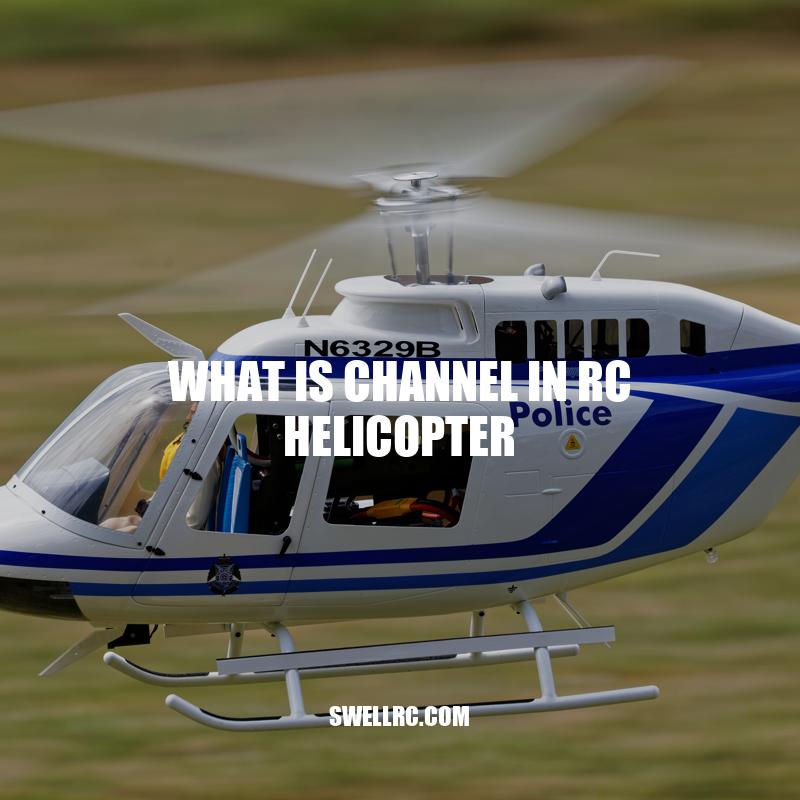Understanding RC Helicopter Channels
RC helicopters can be a source of excitement for both hobbyists and professional pilots. They are small remote-controlled flying machines that require skill and precision to operate. A channel is one of the most critical components in an RC helicopter, as it controls its various parts and movements. Understanding the role of channels in RC helicopters is critical, as it enables pilots to tame these machines and fly them with the desired level of control. In this article, we will explore what channels are in RC helicopters and how they function. We will also look at the different types of channels and the critical roles they play. Whether you are a beginner or a seasoned pilot, this article will provide you with essential information on channels in RC helicopters. By the end of it, you will have a better understanding of how RC helicopters work and how you can become a better pilot.
What are channels in RC Helicopters?
Channels in RC helicopters are responsible for sending signals from the remote control to the aircraft. There are many different channels, each controlling a specific movement or aspect of the RC helicopter’s operation. Here are some of the most common channels found in RC helicopters:
- Throttle Channel: Controls the power output of the motor and determines the helicopter’s altitude and speed.
- Yaw Channel: Controls the tail rotor of the helicopter and helps to stabilize it in flight.
- Pitch Channel: Controls the angle of the rotor blades and enables the helicopter to ascend or descend.
- Roll Channel: Controls the movement of the main rotor blades and enables the helicopter to bank left or right.
Understanding each of these channels and how they work together is essential to controlling an RC helicopter. Many hobbyists find that using simulators can be an effective way to practice their flying skills. There are many free and paid options available online, and they can help pilots learn how to use channels effectively before attempting to fly their helicopter.
For those who want to take their skills a step further, there are also many video tutorials and instructional materials available online. These can provide valuable insights on how to use channels effectively and troubleshoot common problems. Investing in high-quality remote controls and RC helicopter parts can also make a significant difference in the performance of your aircraft, as these components can impact the ability to control your RC helicopter.
How does RC helicopter work?
RC helicopters, also known as remote control helicopters, work through a combination of components and mechanics. Here’s a simplified breakdown of how they work:
- The transmitter sends radio signals to the receiver in the helicopter.
- The receiver processes the signals and sends them to the servos, which control the movement of the helicopter’s blades.
- The blades create lift and thrust, which allows the helicopter to move in different directions.
- The pilot uses the transmitter to control the helicopter’s movements, such as speed, altitude, and direction.
There are various types of RC helicopters available in the market, including beginner-friendly models and more advanced ones for experienced pilots. If you’re interested in learning more, you can check out websites like Horizon Hobby or Amazon’s best-selling RC helicopters.
Throttle Channel
The throttle channel is an essential component of RC helicopters, as it controls how much power the motor puts out. Here are a few key facts and tips to keep in mind about the throttle channel:
| Throttle Channel | Facts and Tips |
|---|---|
| Controls how high the helicopter will fly and how fast it will go |
|
Learning to use the throttle channel effectively is crucial for maintaining control over an RC helicopter. Pilots must constantly monitor the power output and make adjustments as needed to prevent the aircraft from veering off course. With practice and patience, however, even beginners can learn to master this essential channel and enjoy the thrills of flying an RC helicopter.
Why is Throttle Control Important?
Throttle control is important for a number of reasons, including:
- Reducing the risk of accidents: Proper throttle control can help prevent you from accidentally revving your engine or speeding up too quickly, which can cause accidents.
- Increasing fuel efficiency: By controlling your throttle, you can maintain a consistent speed that is not too high, resulting in better fuel economy.
- Prolonging engine life: Over-revving your engine can cause excessive wear and tear on your engine, shortening its lifespan. Using proper throttle control can help prolong the life of your engine.
If you’re looking to improve your throttle control, there are resources available online, including instructional videos and tutorials. Some products that can help improve your throttle control include throttle controllers and foot pedal extensions.
Yaw Channel
The yaw channel is an integral part of an RC helicopter’s control system. Here are some important details about the yaw channel that every pilot should know:
| Yaw Channel | Facts and Tips |
|---|---|
| Controls the direction and stability of the helicopter while in flight |
|
The yaw channel is particularly important for navigating the helicopter during flight. Pilots must be able to quickly and accurately adjust the yaw control to maintain the aircraft’s stability and direction. While it can take practice to master, the yaw channel is one of the most important tools for ensuring a safe and controlled RC helicopter flight.
What are channels in RC helicopters?
RC helicopters are controlled by radio frequencies through a remote control. Channels in RC helicopters refer to the number of independent functions that can be controlled by the remote. The more channels, the more control options the pilot has.
Common channel functions in RC helicopters include:
- Throttle control
- Pitch control
- Yaw control
- Collective control
- Gear control
Different RC helicopters come with varying numbers of channels. Beginners may start with a 2-channel helicopter, while more experienced pilots may prefer a 6-channel helicopter for more advanced control options.
If you’re interested in purchasing an RC helicopter or want to learn more about them, check out websites like Amazon or Horizon Hobby for a variety of options.
Pitch Channel
The pitch channel is a vital component of controlling an RC helicopter‘s altitude. Here are some important facts and tips about the pitch channel:
| Pitch Channel | Facts and Tips |
|---|---|
| Controls the helicopter’s upward and downward movements |
|
The pitch channel is responsible for controlling the helicopter’s altitude, which is a fundamental aspect of RC helicopter flying. Precision and attention to detail are critical things to keep in mind when adjusting the pitch control of the helicopter. It may also take time and practice for pilots to fully control the pitch channel, and advanced pilots may choose to learn reverse pitch techniques. By carefully manipulating the pitch channel, pilots can achieve a smooth and stable flight, performing moves that are both controlled and visually stunning.
What is pitch control in helicopter?
Pitch control in a helicopter is the ability to control the pitch angle of the main rotor blades. By changing the pitch angle, the pilot can change the amount of lift generated by the rotor blades and control the altitude, speed, and direction of the helicopter. Pitch control is achieved by using the cyclic and collective controls on the helicopter.
For more information on helicopter controls, check out websites like www.helis.com or www.robinsonheli.com.
Roll Channel
An RC helicopter’s roll channel is responsible for controlling its side-to-side movement. Here are some essential facts and tips about roll channels:
| Roll Channel | Facts and Tips |
|---|---|
| Controls the side to side movements of the helicopter’s main rotor blades |
|
The roll channel is a critical component of controlling an RC helicopter’s movement. It primarily controls the movements of the main rotor blades from side to side. Mastering the use of the roll channel will allow pilots to perform smooth turns and banking movements, contributing to their overall flying experience. However, it is essential to ensure the stability of the helicopter before performing any significant roll channel movements. With practice, pilots can become more accurate and confident using the roll channel, significantly expanding their range of flight.
What are the 6 channels on a RC helicopter?
Here are the 6 channels on a typical RC helicopter:
- Throttle
- Pitch
- Yaw
- Aileron
- Elevator
- Gear or Auxiliary
Each of these channels controls a different function of the helicopter, allowing for precise control of the aircraft. Additionally, some helicopters may have more or less channels, depending on their specific design.
If you’re looking to learn more about RC helicopters, there are many great resources available online. Some popular websites and forums include RC Groups, helifreak.com, and RC Universe. Additionally, many hobby shops and online retailers sell a variety of RC helicopters and accessories.
Conclusion
Understanding how channels work in an RC helicopter is essential for anyone looking to get into this exciting hobby. Each channel plays a crucial role in controlling the helicopter’s movements and requires practice and mastery to control accurately. The four channels, throttle, yaw, pitch, and roll, provide pilots with an impressive range of control over the helicopter’s maneuverability. With practice, pilots can learn to perform tricks, fly stunts, and execute complicated movements. By understanding the fundamental concepts of how channels work, pilots can take full advantage of their helicopter’s capabilities and become better pilots.
Whether you’re purchasing your first RC helicopter, or trying to improve your flying skills, there are countless resources online to help you along the way. Websites like HobbyTron, Horizon Hobby, and RC Planet offer a wide selection of helicopters, parts, and accessories to enhance your flying experiences. You can also find online tutorials and videos on channels, movement control, and general flying tips and tricks. With dedication and practice, you can master the art of flying RC helicopters and enjoy this exciting hobby for a long time.



